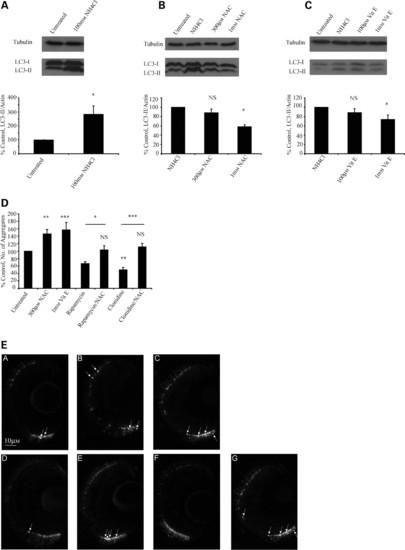- Title
-
Antioxidants Can Inhibit Basal Autophagy and Enhance Neurodegeneration in Models of Polyglutamine Disease
- Authors
- Underwood, B.R., Imarisio, S., Fleming, A., Rose, C., Krishna, G., Heard, P., Quick, M., Korolchuk, V.I., Renna, M., Sarkar, S., García-Arencibia, M., O'Kane, C.J., Murphy, M.P., and Rubinsztein, D.C.
- Source
- Full text @ Hum. Mol. Genet.
|
NAC and vitamin E can inhibit autophagic flux and increase aggregation in a zebrafish model of Huntington′s disease. (A) Ammonium chloride causes significant increases in levels of LC3-II in zebrafish larvae, consistent with an ability to block autophagosome/lysosome fusion. (B and C) In zebrafish, co-treatment with either NAC or vitamin E significantly decreases the levels of LC3-II seen in the presence of ammonium chloride, consistent with their ability to decrease autophagic flux. The panels show western blots for LC3-II against tubulin loading controls. The graphs represent densitometric analysis of three independent experiments. (D and E) NAC and vitamin E increase aggregation, while the autophagy-inducing drugs rapamycin and clonidine decrease aggregation, of EGFP mutant huntingtin in the retina of transgenic zebrafish. (D) shows the average number of aggregates per retina in each condition relative to control. Representative images taken from the retina are shown in (E) with huntingtin aggregates indicated by arrows. (A, control condition; B, NAC treatment; C, vitamin E; D, rapamycin treatment; E, rapamycin and NAC; F, clonidine treatment; G, clonidine and NAC). Note that the rescue seen with rapamycin or clonidine is abolished by co-treatment with NAC (*P < 0.05, **P < 0.01, ***P < 0.001, NS, non-significant). EXPRESSION / LABELING:
|

